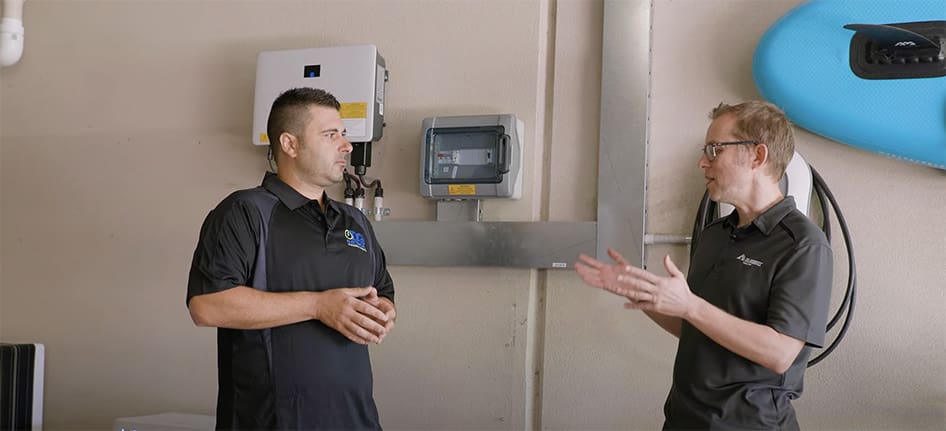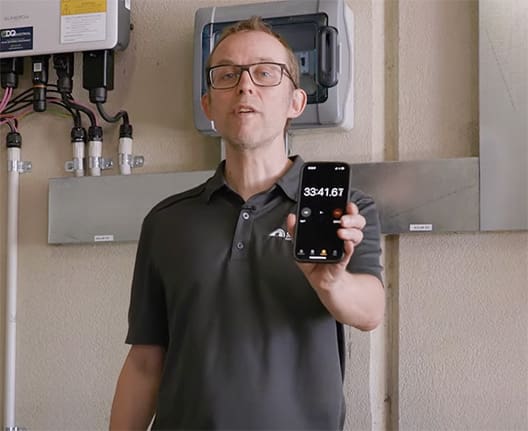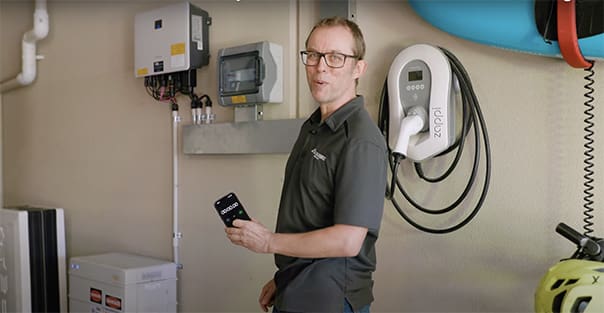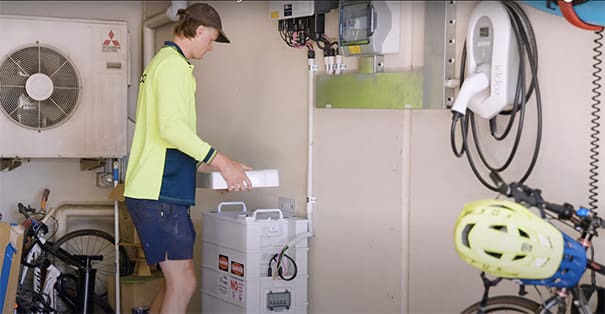One of the things I like about the Sungrow SBR HV battery is its modular design. Sungrow claims it is easy to drop in extra modules after installation – if you decide you need more kWh of storage in the future.
But is that really true?
I tested Sungrow’s claim by adding an extra 3.2 kWh battery module to my year-old installation and timing how long it took to install.
The video above has all the details – but if you don’t feel like watching me drone on, here’s a summary:
Should You Go For A Modular Or Non-Modular Battery?
One of the many choices you’ll need to make when looking into solar batteries is – modular or non-modular.
We recently covered modular batteries in great detail.
What it boils down to is – modular batteries offer more flexibility and cheaper upgrades.
My Battery Needed Pre-Conditioning
One interesting quirk about adding to a modular battery stack is all modules need the same charge before you can add a new unit.
So, the night before, my installer remotely conditioned my battery stack to bring all battery modules to a 20% state of charge, saving hours of waiting on install day.
Interview With Don From DQ Electrical
My initial system was installed by DQ Electrical, based in Gepps Cross, SA. They did a great job the first time around, and I want to keep my warranties under one roof.

I chatted with Don, owner of DQ Electrical
Here’s a transcript of the conversation we had:
Finn: Don, you’ve been installing modular batteries like the Sungrow and the BYD for a while now. Are you a fan of the modular architecture?
Don: We’re massive fans of modular architecture. It gives our customers the absolute freedom to add extra modules as they require.
Finn: What’s your best guess? How long is it going to take today?
Don: Adding one module will probably take us about an hour today.
Finn: So I’m adding one module today, 3.2 kilowatt-hours.
Don: Sure.
Finn: But if I wanted to add, say, three modules, how long would that take?
Don: Yeah, adding one module or three modules is pretty much the same amount of time. It’s literally taking the head unit off, dropping the new modules in, and then replacing the head unit and commissioning. So you’re probably talking an extra 30 seconds per module. On this particular model, you can go up to 25 kilowatt-hours worth of storage, which is eight modules.
Finn: Yeah. Cool. And that’s going to be more than enough for most homes?
Don: Definitely. Most homes, the average home we see around that 16 kilowatt-hours worth of storage generally does it.
Finn: If this wasn’t modular and I wanted to add a second battery, how long would that take an electrician?
Don: To add a second battery, you’re probably talking six to eight hours worth of work to put in a full battery with cabling and wiring. Going modular from the beginning allows you to have everything in situ and ready to go, and then it’s simply dropping extra batteries on top of the stack to get that desired kilowatt-hour storage that you’re looking for.
Finn: Cool. Well, let’s see if you’re right and if you can get this module on in under an hour.
Don: I’m sure we will.
Race Against The Clock
Don predicted adding the module to my stack would take about an hour. I started my stopwatch, and his team got to work:
The result?

33 minutes later, my system was ready to go.
I now have 16kWh instead of 12.8kWh installed in under an hour.



 RSS - Posts
RSS - Posts



One of the problems – across the board with ALL technology is their rapid development.. So modular idea is great but how long before technology upgrades and you would not have the ability / stock to upgrade. Our SolareEdge initial 6.7 kw system was great .. 12 months later things have moved on .. so and upgrade was not simple but involved adding a second inverter and another 6.7 kw system of panels .. BUT that’s life in our fast changing world ..🤔
I also had a pretty good experience with Sungrow doing an upgrade 12 months after purchase. They also still sell the same battery.
The installation wasn’t as fast as this one, as it was the first time the installers had done it and they didn’t level the battery the night before.
You may want to amend the quoted conversation, 25.6kwh or 8 battery modules is only for 3 phase, 19.2kwh and 6 modules is single phase in Wester nAustralia
I recently expanded my BYD battery. What I found out was that it was hard to find an electrician to do it for less than $1,200 (labor). I was told that “the license” was expensive and they charged for that. Thanks to Finn and Solar quotes I was able to find some reasonable electrician. Thank you Finn and the team.
I started with three modules (9.6kw), a year later expanded to five (16kw), next week (two years later) we’re adding another three for 25kw.
I’m going with a new installer, the original wouldn’t return my email requesting a quote, to be honest, I don’t even know if they’re still in business….disappointed doesn’t express how I feel.
Not the first time this has happened with solar suppliers either, it seems good follow up these days is hard to find.
I obtained the new installer through Solarquotes so, thanks.
Back to batteries though…😉
Since fitting the system, we’ve had zero power bills, we’re always in credit in spite of falling FIT.
Recently changed electricty supplier as a result, hunted the best FIT and still in credit after three months.
Regardless of FIT, we’re now future proofed against electricity prices.
Best decision we made!
Because of mg experience and that of other described here, you might like to confirm your usable capacity.
An easy method is:
1 Revise the backup reserve to 0% soc Device/EnergyStorage System/Setting/Power Control/BackUp Mode[enable]/Reserve Battery SOC for offgrid[value 0%]
2 in thr evening set a forced charge to 100%SOC commencing at time you do it so yoh csn confirm command is executed, ending at 24:00
Device/EnergyStorage System/Settings/Power Management Paraemeters/Forced Charging/ etc.
3 run sufficient appliance to ensure battery discharges completely before charging recommences at sun up.
4 note in the Isolarcloud ap, the amount discharged. In your case it should 95% x 25.6kwhs, or very very close to it, 5% deducted for the hidden reserve that is maintained by default.
In my case, my 19.2kwh system discharges no more than 16.5kwhs and on many occasions quite a bit less.
Interesting. Last week just added another battery to my current 10kwh SolarEdge battery. Total now 20kwh. Current battery has been in use for 18 months. Previously had a SolarEdge inverter over 4 years now with 11kw Solar. Hence have kept in the SolarEdge ecosystem.
Installation of 2nd battery was surprisingly simple only taking 3 hours, start to finish. Involved additional wiring from 1st to 2nd battery and a software update. No ‘balancing’ of the battery percentage required. The SolarEdge App recognised the new arrangement immediately, so did Amber SmartShift and starting filling for the evening grid dispatch. Import / Export from battery has now increased from 5kw to 8kw.
While not as ‘modular’ as the SunGrow, the SolarEdge upgrade was very straightforward.
Sig would be probably 10mins
Video it to prove it!
The only caution that I have is that the batteries need well balanced in order for them to optimally charge. In effect the charging is limited by the worst performer. So, for example, a battery that has deteriorated to 80% capacity will cause all other batteries (in parallel) to only charge to 80%.
I know this is the case with adding a battery to a caravan and suspect it is the same for house batteries.
If so, the message is don’t wait too long to add extra batteries.
The amount of time to install is not such a big deal imho. What’s a much more salient consideration is the availability (and interest) of installers, bureaucratic rules, and installation site parameters such as switch board capacity, location availability. and of course $$$. So much is changing so quickly that it’s important to figure out what one wants and get it all done on one hit. That’s my experience anyway – WA consumer — metropolitan region.
The Sungrow modular batteries are a tried and true system, but Sungrow recently launched the new SBH series of batteries which are more expensive but offer a higher amperage of discharge. Given this, it may be worth asking if the SBH series is the future of Sungrow batteries or will Sungrow continue to offer both ranges for ten plus years to come?
Like the previous blog, I’m more interested in whether Sungrow will raise their warranty to 70% capacity after ten years in order to meet the new government requirements for a subsidy.
You might think you have 16kwhs but I doubt it.
I would be very wary of expanding a Sungrow battery installation.
Since I doubled the number of modules, to 19.2kwhs I only ever get 16Kwhs discharged from 100% state of Charge “SoC” to 0%. Sungrow’s data sheet & marketing state their battery power is 100% usable. This is false & misleading, by Sungrow’s own admission to me, in writing. In order to justify the reduced capacity of my installation Sungrow say that when their Isolarcloud app shows 0%SoC it is really 5% and this 5% is not usable.
And this isnt half my problem, 1/3rd of it actually.
I am not sure if my 9.6kWh system was actually that or even only 95% of that. My 19.2Kwh system is really only 16kWhrs – that’s a shortfall of 15%+. And Sungrow are not interested in satisfying that issue.
Sungrow might still be competitive in the market even if their battery isnt 100% usable. I suggest that my 16kwhs for the price of 19 kwhs is not though.
I made my decision on the basis that it was 100% usable. And even if only 95% usable I have a missing 10%. It is very disappointing to say the least.
Also, I was aware Sungrow and the installer could control my system to trouble shoot etc. However, I had assumed that before any such tinkering, such as draining the battery at 5kw to the grid for a pittance of a FiT late in the afternoon when I could have used it to heat the house or charge an EV, Sungrow would have TOLD me in advance. Actually, I thought that they might be REQUIRED TO ASK if they could. But no. Even after complaining about it twice before they do it again. Perhaps they are all like this but I would be surprised.
I wonder if regulators are aware of this, especially as they are trying to encourage householders to install these systems only for them to be controlled by faceless unaccountable people without permission of the actual owner of the property.
Re: balancing old with new modules as mentioned above: Sungrow expansion installation manual sets out requirements. This is to be achieved by discharging exiting battery bank to a level indicated in the manual based on manufacture date of new modules. Manufacture date is indicated by the serial number of modules. Mine should have been discharged to 24% SoC but were taken to 19%.
Sungrow’s first assessment of my apparent shortfall of 15% by my observations was that it was an equalisng issue that would soon rectify itself . They attributed 5% of loss, of 15% shortfall to this. After a couple of months & now 4 x complete 100% discharges nothing has changed.
If youre a Sungrow owner and curious, suggest you do the simple calculation of: Amount of discharged Kwhs at bottom discharge cycle in the morning divided by (SoC% at midnight MINUS SoC% at bottom of discharge cycle) and see if you get anywhere near what you think your capacity should be. If not, then force charge to 100%SoC stopping at midnight, and try to completely discharge the battery in the early morning hours to Zero%SoC without any further charging/discharging cycle and see if you get anywhere near what you think your battery capacity should be.
I would be interested in your results.
To get it to Zero%Soc you would also need to adjust the backup reserve % to 0% as well. Even then, the battery will still retain roughly 5% when the app graphic shows 0% and discharging stops. A more accurate SoC% is apparently shown in “Device Information”.
The other point to be wary of when expanding Sungrow battery modules, and probably other manufacture installations, is that your battery will be degrading from the date of manufacture. Mine dropped to 99% after 4 months of use. I doubled it 3 months later & still 99% State of Health “SoH”. If this was a few years down the track with 80% SoH, the new 9.6Kwhs of batteries I just bought would likely actually only add 7.7Kwhs but don’t expect Sungrow to tell us that
I’ve had a similar experience with expanding my Sungrow SBR battery system and getting a much lower capacity than I expected. Over the past couple of years, starting with a 12.8kWh system, I doubled it to 25.6kWh, then doubled it again to 51.2kWh. Whilst I have experienced excellent customer service from Sungrow and my installer, I do not have as much confidence with the battery hardware/firmware and it’s ability to maintain an optimally balanced set of modules. With the first expansion the installer was not aware of the manual balancing requirements – I don’t blame them as I also incorrectly assumed the BMS system would take care of it. The installer returned and manually balanced it. Since then I have spent way too much time monitoring its capacity and module min/max voltages via modbus. After only getting around 15-20kWh out of the 25.6kWh system, I sent Sungrow some charts showing the module min/max voltages and how the old and new modules were out of balance. To their credit they offered to do a warranty replacement on the whole stack. Wanting to expand my capacity, and not wanting to deal with new/old balancing issues again, I arranged to get another new stack installed at the same time. Unfortunately the balancing issues did not disappear and it seems like the worst module in any stack limits the discharge capacity of the whole system and the best module limits the charge capacity. A Sungrow engineer visited and manually balanced both stacks but within a week it was unbalanced again. I am currently only getting around 33-43kWh out of an almost new 51.2kWh system. There are a couple of modules that appear to be dragging everything down and again Sungrow have offered to do a warranty replacement for those modules. Once that happens I will be monitoring the capacity again with my fingers crossed. I do wonder how many Sungrow battery owners are actually getting the usable capacity they paid for and how many might be unaware if they’re not measuring it.
Sonnen is supposed to be upgradable as well but I went back to add more storage to my 10kWh battery after 5 years and the answer was no?
I went modular as well, got 3/4 modules installed. What they didn’t tell me, is that if I decide to add another module, I’m required by Belgian law to have it recertified and reregister the capacity I have. I’d call that a non-starter…
So was it better, worse,. No results, state outcome not ha ginger with no results
Ho Malcontent,
I think you may have a predictive text problem with your content.
Please rephrase the austin; and proof read it.
Cheers
So yours is three phase system Finn?
Hi Mike,
It’s single phase.
Finn, I asked previously if your own system is three phase because the company that installed my 19.2kWh of Sungrow SBR battery told me that my six modules cannot be expanded to a stack of eight as mine is a single phase system. I’m advised by them that a stack of eight is only possible for a three phase system but I could go for an installation consisting of two separate four power module units including an additional base and header unit for the second stack.
Such a system expansion is significantly more expensive than merely adding two additional power modules and we decided against it as too expensive.
Is the information I was given correct?
It’s my impression that the vast majority of domestic 240V mains connections in Australia, and more particularly W.A., are single phase and therefore an eight module stack would be unavailable to most people. Am I incorrect in saying that?
Hi Mike,
This is the official Sungrow cheat sheet. Parallel stacks are possible with the extra base/lid/bms unit.
https://service.sungrowpower.com.au/GD_202405_SBR%20and%20SBH_Cross%20Reference%20Chart_V1.3%20Final.pdf
I am unsure what this Sungrow sheet is telling us.
Hi Neville,
If you look at the RHS you can see the different models of inverter.
The battery stacks are listed at the top, so the squares in yellow indicate a workable but less than ideal system. If the stack is small, the voltage is low and it may struggle to have enough surge capacity.
Red doesn’t work because voltage is too high.
Green is good.
If you select a green system, you can double, triple or quadruple the *storage capacity* by paralleling equal sized stacks of batteries.
ie the SH5.0RS 5kW single phase inverter can’t have a single stack of eight, but it can have two stacks of four, if you really want 25.6kWh of storage
Thanks Anthony. That lays out the situation perfectly for single and three phase installations. It would have been great if our supplier had advised us of this when we were sold a system supposedly expandable to 25kWh. Clearly they didn’t know though as they attempted to install the additional two units before learning that it wouldn’t work. I question why a significant supplier of Sungrow equipment was unaware of this fact that deprived us of a larger battery and wonder how the end user can avoid such a situation. As our supplier/installer was left out of pocket by our attempted install it appears likely that Sungrow may have been less than thorough in providing training/information to them in the first instance. Just another unsatisfactory outcome in the solar industry it appears.
So, if I am correct in my view that most domestic installations in Australia are single phase, very few are actually able to install a 25kWh Sungrow battery system and would therefore be wise to look elsewhere if they think they may ever wish to install or expand beyond 19.2kWhs of storage.
Hi Mike,
Sungrow are pretty responsive I’ve found. They run an active social media page with instructions, alerts, of course some new features & promotions too.
Things like this “cheat sheet” battery compatibility chart are featured via socials with links back to the Sungrow Web page.
Like any brand, they have their foibles which installers sometimes find out the hard way.
Many brands don’t offer more than 2 or 3 increments of perhaps 5kWh storage, and in your instance a single phase Sungrow will accept parallel sets so you can have significantly more. While it may be more expansive, there’s flexibility insomuch as you could comply with a 5kW DNSP inverter limit but have a great deal more battery.
Many Australian houses are single phase but increasingly 3ph is more common, and will only grow as a proportion.
Ahhh this is where Sigenergy is superior as each Battery module has it’s own BMS. You can mix & match battery sizes too! 5kwh or 8kwh. Ahhh the joys of Parallel batteries. Traditional Series Batteries are the limiting factor. Complete redesign & new tech required.
Sig won’t limit the new batteries to the degraded older batteries due to it’s DC-DC Optimizer’s. All other brands are just old tech now. They should be a lot cheaper than they are.
It was a similar experience for me with my Pylontech modules (US5000B). I started with two of them (to replace a dead Redflow ZBM), and expanded to three when money allowed. Installation of the first two was a significant job: put the rack in place; put the batteries into the rack; wire them up. Installation of the third was simple: get the existing modules charged to 50%, rack the third while that was happening, then connect the cables.
Because they’re 48 VDC, I could – in principle – get more modules and just rack and wire them myself, no electrical license required. I do intend to expand my battery storage further, for a number of reasons, but it’s a question of money. Three or four modules is the sweet spot in terms of load on the batteries and cost. More than that, I want, but money is a problem in the near term.